TOMMY DAVIS – Every-body’s Drummer of Choice
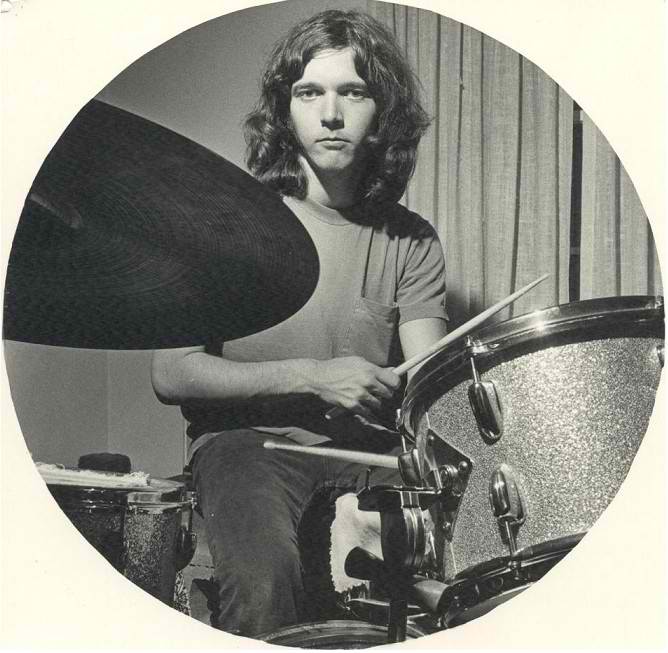
Tommy Davis at the drums
In 1964 Tommy Davis began accumulating photos, newspaper clippings, handbills and recordings which chronicled his career as a drummer. This collection is preserved in three large plastic storage bins. Fortunately, this compilation helped us build the following timeline for much of his musical journey, which spans over fifty years.
Davis designates time to work on music theory and practices drumming every day. He is relaxed, reflective and in control. He is not prone to allowing a conversation to wander aimlessly, and has a knack for returning back to the exact point where it went off course. He listens intently. It is evident why he has been and still is the drummer of choice for so many West Michigan bands. He is an experienced, dedicated, hard-working and gifted musician, as well as being pleasant, intelligent and focused.
Tommy’s reputation as a drummer is renowned amongst West Michigan musicians. He may have played with more bands and musicians than any other drummer from Grand Rapids. Yet his career has not been confined to local success, as he toured Europe in 1979 and 1980 with prominent musicians like Roy Clark and Clarence “Gatemouth” Brown. Tommy Davis has also played in just about every American city that one can imagine.
Music in the bloodline
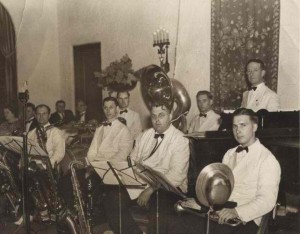
Tommy’s grandfather, Tony Smits, is situated in the top row of this photo, at the extreme right, with the other unidentified members of the Tony Smits Orchestra. They served as a dance band that performed for decades in the Grand Rapids area.
Many notable musicians are born into musical families where at least a parent, sibling or grandparent was musically inclined. Davis is not an exception. His maternal grandfather, Tony Smits, was a popular pianist and dance band leader during the 1930s and 1940s in Grand Rapids. Born in 1893, he was playing publicly as early as 1921. He was the conductor and pianist of the Tony Smits Orchestra for twenty five years. One of the numerous venues he performed at was the Silver Cloud (now Kuzzins) on Leonard N.W., near the corner of Alpine. During the course of his career, he worked with local musicians Roy Middleton and Vic Hoek. He also served as the organist for the Elks Club from 1955 to 1963. Tony passed away in November of 1968, just after Tommy turned 19.
Tommy Davis’ Early Career
Tommy was born on October 8, 1949. After graduating from Burton Junior High, he attended South High School for one year. Tommy recalls that while walking home from junior high school one afternoon with a few friends, they heard a band rehearsing at a house on the corner of Union and Paris S.E. They proceeded to knock on the door of this home. The group members allowed them to come inside and watch their rehearsal. The band that they heard was known at that time as Lyn and the Invaders, a very popular rock group from Grand Rapids during the 1960s.
Davis sang for the Tower Club Choir at Fountain Street Church as a youngster. While still in junior high, Tommy’s parents bought him his first drum set. He worked to pay them back. He received no formal training. In March of 1964, Tommy performed with some friends (Tom Babb, Dave Howard and Pete Thompson) for a dance at Burton Junior High, which was probably his first public concert.
In 1965 Tommy and his family moved to East Grand Rapids. He promptly sited some other budding musicians at school and put together a band called Tommy and the Deuces with Dave Gigowski, the late guitarist Ed Powers and George Lang. This band was eventually renamed ”The Group.”
Peter and the Prophets recorded a Fenton single in March of 1966 with their namesake, Pete Samuelson. By September of 1966 the original group began to dissolve and Davis was asked to join brothers Mike and Pete Boylan, and singer Dave Bixby replaced Pete. John Gillette was also a member of this group at one time. At first they called themselves “The Judges,” but they soon decided to reclaim the Peter and the Prophets title because that band had already developed a reputation and a following. They played on top of the East Grand Rapids water tower in September of 1966, as well as a few dances within the next year. With Tommy onboard they competed at and won a local battle of the bands competition in early 1967. As a result, they were invited to perform at the city-wide battle of the bands championship with the Steel Blues, the Jades, Intruders and Soulbenders at the Place on Plymouth N.E. They also provided music for various local dances as well as supplying music for Herpolsheimer’s and Steketee’s fashion shows.
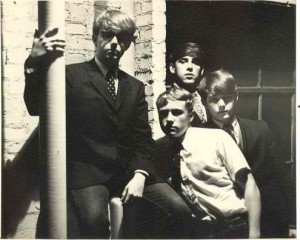
Peter and the Prophets. This edition of the band included brothers Mike and Pete Boylan in the foreground, Tommy Davis (far right) and Dave Bixby, in the rear.
In June of 1967, Tommy graduated from high school, and enrolled in classes at Grand Rapids Junior College that fall.
Tommy’s next band project included composer, vocalist and keyboard player Aris Hampers and guitarist Jeff Boughner, both formerly with the Soulbenders. Dave Pryce played guitar and Joe Sarnicola was on bass. On 10.6.68 the Phlegethon performed for the Autumn Equinox concert which featured the MC5, The Frost and the Psychotics. During the following month they supplied the music for a dance at the Plantation on Plainfield N.E., located where the north end of North Kent Mall once was. The Phlegethon also performed at the Place on both December 9, 1968 and January 27th of 1969. By September of 1969 the Place was renamed Lothlorien, and they opened for Alice Cooper at a concert there in the same month.
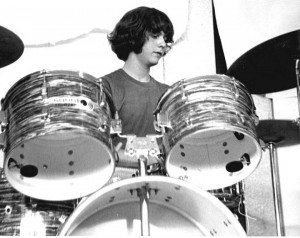
Tommy Davis while he was with the Phlegethon
On 3.25.69 they recorded their hit single, “You’re No Good,” which hit the local Top 40 charts in May. This recording was made at Dave Kalmbach’s Great Lakes studio in Sparta. Tommy continued his education during his tenure with this band. Upon graduating from Grand Rapids Junior College in 1970, he quit Phlegethon and moved to Kalamazoo to attend Western Michigan University. At this point, Randy Marsh took over on drums.
In 1971, Tommy was involved in a recording project with a Grand Rapids band called Fast Eddie. They recorded a single at Phil Robert’s studio on West Leonard. The songs were ‘Hey Lou’ and ‘Do You Wanna Make Love.’ The musicians were Jack Bricker, lead vocals and guitar; Dave Pryce, guitar and vocals; Doug Mull(?) on bass, and Tommy on drums.
Jack eventually moved to Los Angeles and became a makeup artist. He worked in that capacity for the Michael Jackson “Thriller” video. Here’s a link to the website page where you can hear Fast Eddie’s music:
http://www.westmichmusichystericalsociety.com/fast-eddie
The Kalamazoo Years
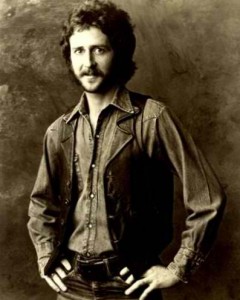
Larry Ballard
For well over a year Davis concentrated on his college classes. At this point, he had only three courses to finish to obtain his bachelor’s degree, but Tommy missed playing music. About that time, he was notified that Larry Ballard and the All Nite Tennis Shoe were looking for a replacement drummer. He auditioned and replaced Larry Avery who had resigned and was moving to Nashville. Davis remained with Larry Ballard until 1972, when Ballard also left for Nashville, having secured a recording contract with Electra Recordings. At that time, Tommy and John Chamberlain proceeded to form a show band in Kalamazoo, entitled Sweet Maya. The other band members included Gail Baker, Jan Lakers and Mark Bowen. Until Sweet Maya disbanded in 1976, Tommy worked with them as often as possible, including three engagements during their last year together.
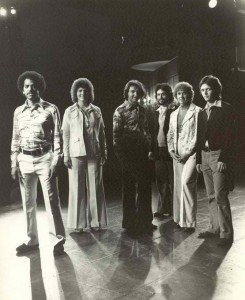
Sweet Maya (L-R) John Chamberlain, Gail Baker, Rob Hayes, Mark Bowen, Jan Lakers and Tommy Davis
During the early 1970s Davis also kept busy working around Kalamazoo with a country band called Country Roads, as well as the Dick Root Band. Root eventually worked as a supporting vocalist for country stars Tanya Tucker and Charlie Pride.
In the mid-1970s, Ronnie Fray asked Tommy to drum on his album called “Put This in Your Ear,” which he recorded at Bryce Roberson’s “Uncle Dirty’s Sound-Machine Studio,” in Kalamazoo. Tommy Davis: “most of the tracks were done by the time I was called to duty. I drove to Kalamazoo and played on ‘Hit the Brix,’ ‘This Here Song,’ and ‘Cold November.’ Randy Panda played on the rest. Ronnie and the other musicians had already finished everything else. Fray recalls that strings were later added to the album in Memphis and Detroit.
Nashville, U.S. Tours, Europe and Russia
Tommy Davis: “Around 1974 Larry Ballard phoned and said he was ready to go on the road to promote his latest album. I moved to Nashville and toured with Larry for a while. The middle and late 70s were very exciting and busy years for me, as I worked with numerous bands and traveled a lot.”
“It was also in Nashville that I met singer/songwriter Linda Hargrove. Larry Ballard’s gigs started to dry up so I joined Linda Hargrove’s ‘The Go-Fer Broke Band.’ It was with her that I made my first appearance on the PBS-TV series called Austin City Limits in November of 1977. We opened for Johnny Rodriquez, with Willie Nelson sitting in. We also recorded one of Linda’s songs called ‘Let it Shine.’ This was about the same time that I played at the Grand Ole Opry and for the Ernest Tubb Record Show. I also worked for a while with Pam Rose at the Exit Inn in Nashville. In 1978, Linda’s gigs were also diminishing.
I worked with Ronnie Fray during this time period, as well. We toured numerous states including Texas, Minnesota, Louisiana, Mississippi and New Mexico. In March of 1979 Ronnie Fray asked me to come to Titusville, Florida where his group held a steady engagement. I needed the money so I left for Florida. This is where I met Chuck Bob Carnes. Throughout these years I was traveling back and forth between Nashville and Grand Rapids to play various jobs. Even while I was touring with artists like Linda, Gatemouth Brown or Ronnie there were ‘down’ times in our schedules. Then I had to go back home to Grand Rapids to work with someone else until I could go back out on the road again. I wanted to play. I was so used to playing all of the time.”
“In 1979 I received a call from Cal Freeman, a pedal steel guitar player, who was working with Clarence ‘Gatemouth’ Brown. Cal told me that they needed a drummer. So I left Titusville and drove to New Orleans to hook up with the Gatemouth Brown group, working as the drummer for his road band.
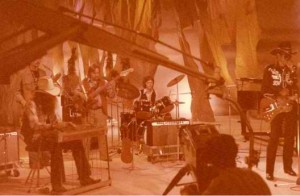
The Clarence “Gatemouth” Brown band during the taping of a Russian television show. Cal Freeman is seated at the left side of the picture, playing pedal steel guitar. The bass player to his right is unknown. Tommy Davis is at the drums, and Brown is at the extreme right.
The next two years consisted of constant touring between every American city you can think of, as well as playing some overseas engagements. In July of 1979 we performed at the Montreaux Jazz Festival in Switzerland. We also did a six-week tour of the Soviet Union that same summer. It was prior to the Soviet Union tour that we had played Montreaux, London, and Brussels with Roy Clark, Barbara Mandrell, the Oak Ridge Boys, and B.B. King. All of these bands were part of a package tour. However, before I moved on to Russia with Gatemouth, all of these other entertainers returned to the U.S. In 1979, Roy Clark and Gatemouth Brown recorded an album called ‘Makin’ Music.’ Our band appeared on Austin City Limits. http://www.youtube.com/watch?v=HoeBEFDrnZs&NR=1 We also taped some Hee Haw TV shows at a studio in Nashville.”
“In 1980, an old knee injury flared up on me while I was in Tampa, Florida. It was impossible for me to play the drums at that time. I flew home and ended up resting on the couch for six weeks. I had plenty of time to collect my thoughts, and I decided that I had lived out of a suitcase long enough. I kept asking myself if I wanted to keep doing this the rest of my life, with no insurance, no pension, and nothing else you could depend on. The pay I received as a traveling musician was not that great.”
“But I did return to playing once my knee healed. It was mostly local gigs with Chuck Bob Carnes, Ronnie Fray and The Cedar Creek Band, and a band called Foxfire in 1981.
This is about the same time that I did a lot of work recording commercials at the new River City Studio on Fulton Street in downtown Grand Rapids.” During 1981 and 1982 Davis was performing around Grand Rapids with Ronnie Fray and the Johnson Brothers. In November of 1981 he created a duet with Randy Johnson. During the 1980s he also played with Jimmy Phillips.
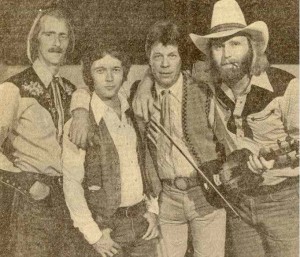
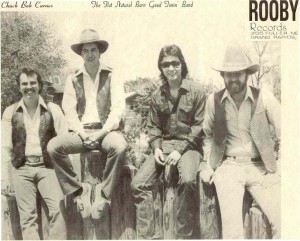
The Flat Natural Born Good Timin’ Band, during 1983. (L-R) Chuck Bob Carnes, Dennis Brown, Tommy Davis and Rich Johnson
After Davis renounced being a traveling musician he returned to college and finished his bachelor’s program at Western Michigan, around 1985.He commuted from Grand Rapids to Kalamazoo. After graduating, he was employed by Precision Data Products and eventually acquired a job with the State of Michigan, where he worked for twenty years.
“My last full time band was Cedar Creek at the Westwood Ranch House. In August of 1989 I played with them at the WCUZ Country Showdown. Somewhere around 1985-86 I cut out playing full time. I still played a little but took a break from performing every night. “
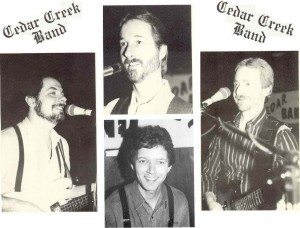
The Cedar Creeek Band. Pictured in the top row, from left to right, are Jimmy Britten, Craig Loveless, and Jimmie Van. Tommy Davis is the other gentleman with the suspenders, located at the center of the bottom part of this photo
“I believe it was about 2002 or 2003 when I began playing with more regularity, again. At that time I joined Weezil Malone and the King Size Blues Band, to start getting my chops back. I also hooked up with a country band called Luke Galloway and the Drifters.”
In 2007 Tommy created an Excel sheet to keep track of his playing schedule for that year. During the course of that year he played for no less than sixteen bands, including Fatt Lapp Blues Band, Cruel Moon, Dusty Chaps, Mark Swanson, HyRyder Band, and the Eastones. He has managed to juggle his calendar to be on call for numerous bands throughout the last decade. As stated earlier, he remains the drummer of choice for many West Michigan groups.
Currently, he creates the beat for the Weatherheads and the13th Hour bands, as well as Dusty Chaps and the City Slickers. When he serves as a church musician, he plays bells for Trinity United Methodist Church and has also done some drumming at Unity Church in Walker.
After returning to Grand Rapids in 1980, he received an offer to tour with Tanya Tucker, which he refused. Occasionally Davis has moments where he asks himself, “what might have happened if I had stayed in Nashville?” We do know this much for sure: Tommy is no longer living out of his suitcase, and he certainly isn’t struggling to find work as a drummer around Grand Rapids.
5/24, 6/12

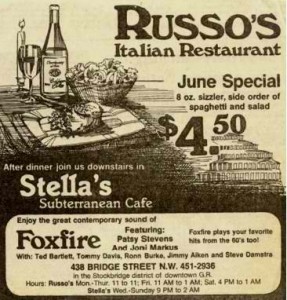
6 Responses to Tommy Davis – Mr. Drummer